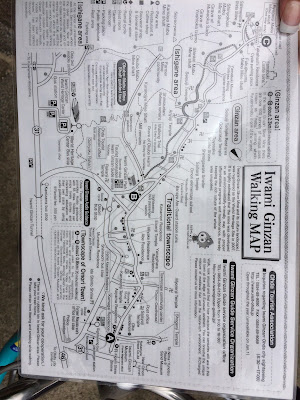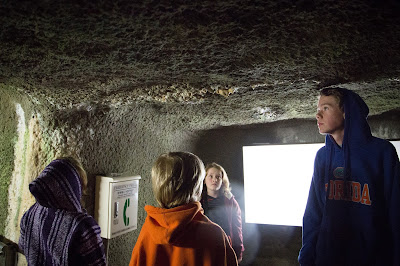So my Japanese friend, Chie, had been trying to plan a day trip for my Mom since my Mom arrived in Iwakuni on March 16 to visit for 90 days. Unfortunately, the first few plans got rained out. But, finally, Mother Nature cooperated and we managed to stick with a plan... visiting the Iwami Ginzan Silver Mine Site, which was Japan's largest silver mine until it closed in 1923. It had been an active mine for more than 400 years and is now a World Heritage Site. It takes about two hours to drive there and you could easily spend the entire day there, checking out the all of the different sites, shrines and shops.
When you arrive at the National Heritage Site, you park there and take a bus (plan on about 600 yen round trip per adult and about half that for kids) to the base of the Silver Mine town. Nearby the first stop where the bus drops you off is a bike rental shop. This shop is important to visit.
What Chie neglected to tell us (and she neglected to tell us ON PURPOSE because she'd knew we'd balk at the plan) was that it was a 45-minute uphill walk to the mine and hamlet locations. OR it was a 15-minute uphill ride by electric bicycle for an additional 1,000 yen per person. We were pressed for time and the kids were clamoring to have a chance to ride an electric bike, so, despite the fact that I had not ridden a bicycle since college (once you go over the handlebars in junior high, then high school, and then again in college, you know when to call it quits) and my Mom was pretty sure she hadn't been on one since before I was born, we rented electric bicycles... and obviously lived to tell the tale.
I have to admit that if I was to purchase a bicycle for myself at any point, I am definitely purchasing an electric one. You still pedal, but the bike does about 90 percent of the work. So, I felt like I was getting a good workout but didn't have to sweat much. The perfect exercise plan for me!
 |
| We got an English map from the bike rental guy, but we also received an English brochure at the main mine site. You can also download it from the website (link in the first paragraph of this post) |
Once we got up the hill, we parked our bikes and then walked up the hill a bit further for the main mine entrance.
 |
| Follow the arrow on the road to get to the mine entrance. You will go through the mine and then come back down the road that forks to the left. |
As we walked, we saw hundreds of other mine entrances. Each is numbered. Most are fenced off.
None of them are Big OK American sized until you get to the main mine shaft.
Once through the main mine shaft, we walked back towards the parked bikes, stopping at a shrine and several tiny hamlet ruins that use to be where the miners and their families lived.
Much to my delight, I even managed to happen upon a Morel mushroom.
Once through with the main mine area, we hopped back on our bikes (your 1,000 yen gets you two hours of rental) and headed back down the hill... with the "electric" art turned off. You don;t need help accelerating down these hills. By the way, if you hadn't already used your common sense, if you have small children, you will either want to walk the hill, or avoid this trip. Or, inquire about electric bicycles with baby seats on the back. There are regular bicycles but unless you are a bicyclist already, this option is not recommended.
At the bottom of the hill, near the bike rental area, is the Rakan-ji Temple and Gohyakurakan. They are across the street from one another. At the temple you can wash your money with a strainer, which means you will earn even more money. But don't forget to donate some to the box next to the pool and strainers! Karma, people karma. There is an entrance fee of 500 yen per adult and 200 per child.
Once we captured all the photos we wanted to get of the temple, we returned the bikes (no one launched themselves over the handlebars - #winning!) and moved on to walk the Omori District village. It was a random Friday, so many of the shops were closed, but there were still a few open, and plenty of restaurants and cafes. It was a cool little town that reminded my kids of a Japanese version of Tombstone, AZ (the ghost town).
 |
| A number of buildings had this really cool etched glass. I never saw anyplace selling it, which I was kind of bummed about. |
Many of the mailboxes were very decorative, even creative.
We also stopped at the former Kawashima Family Residence, which was the home of a samurai who acted as the town's mayor, so to speak. The family was in charge of managing all the mining operations in the area between 1610 and 1868. So, I'm assuming it wasn't an elected position. I highly recommend stopping at the residence. It is the only historical Japanese home that had furniture being "used" as it would have been back when the family lived there. Most historical residences just have empty rooms, which makes it hard to imagine what life was like back then. Below was a display in the loft: the samurai's armor and weapons.
The road is quite long and takes about 20 minutes to walk if you don't stop... which you will. But at the end of it was a quaint Japanese restaurant with a tasty, reasonable priced lunch. The benefit of this particular place is that it can serve large groups of people. Many of the other restaurants were simply small cafes.
There is another bus stop across the street from the restaurant, so we just walked over there and boarded the next bus, which took us to the parking lot where we left our car.
This trip was fun for everyone in our group, and you were able to learn a lot about the historical culture of the area. I recommend allowing about 6 hours to see everything. We did it in 4, but felt rushed, due to commitments back at home.




































No comments:
Post a Comment